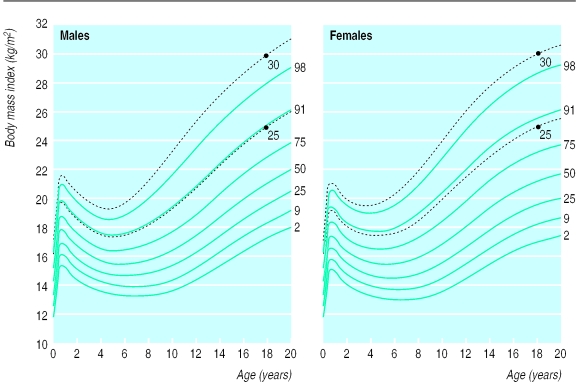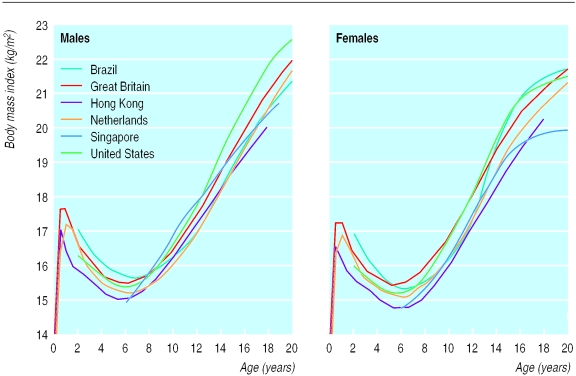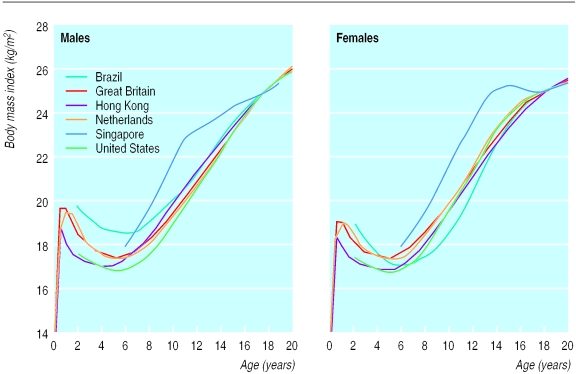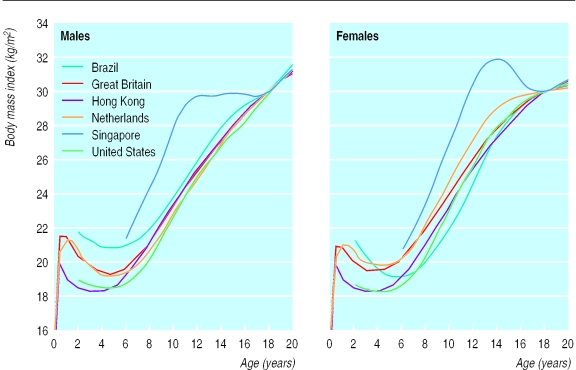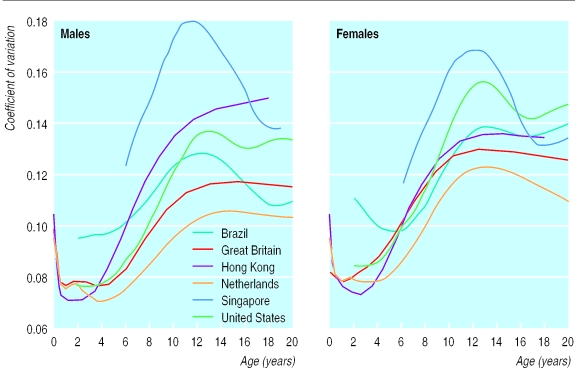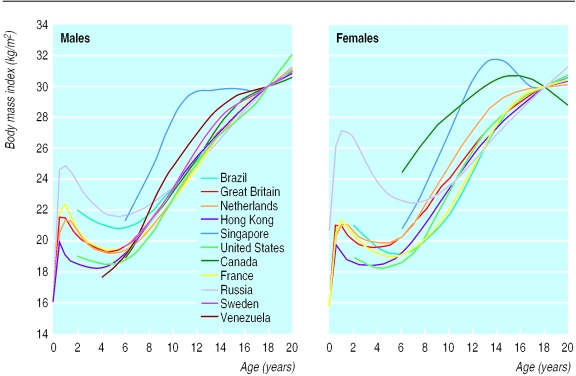Abstract
Objective
To develop an internationally acceptable definition of child overweight and obesity, specifying the measurement, the reference population, and the age and sex specific cut off points.
Design
International survey of six large nationally representative cross sectional growth studies.
Setting
Brazil, Great Britain, Hong Kong, the Netherlands, Singapore, and the United States.
Subjects
97 876 males and 94 851 females from birth to 25 years of age.
Main outcome measure
Body mass index (weight/height2).
Results
For each of the surveys, centile curves were drawn that at age 18 years passed through the widely used cut off points of 25 and 30 kg/m2 for adult overweight and obesity. The resulting curves were averaged to provide age and sex specific cut off points from 2-18 years.
Conclusions
The proposed cut off points, which are less arbitrary and more internationally based than current alternatives, should help to provide internationally comparable prevalence rates of overweight and obesity in children.
Introduction
The prevalence of child obesity is increasing rapidly worldwide.1 It is associated with several risk factors for later heart disease and other chronic diseases including hyperlipidaemia, hyperinsulinaemia, hypertension, and early atherosclerosis.2–4 These risk factors may operate through the association between child and adult obesity, but they may also act independently.5
Because of their public health importance, the trends in child obesity should be closely monitored. Trends are, however, difficult to quantify or to compare internationally, as a wide variety of definitions of child obesity are in use, and no commonly accepted standard has yet emerged. The ideal definition, based on percentage body fat, is impracticable for epidemiological use. Although less sensitive than skinfold thicknesses,6 the body mass index (weight/height2) is widely used in adult populations, and a cut off point of 30 kg/m2 is recognised internationally as a definition of adult obesity.7
Body mass index in childhood changes substantially with age.8,9 At birth the median is as low as 13 kg/m2, increases to 17 kg/m2 at age 1, decreases to 15.5 kg/m2 at age 6, then increases to 21 kg/m2 at age 20. Clearly a cut off point related to age is needed to define child obesity, based on the same principle at different ages, for example, using reference centiles.10 In the United States, the 85th and 95th centiles of body mass index for age and sex based on nationally representative survey data have been recommended as cut off points to identify overweight and obesity.11
For wider international use this definition raises two questions: why base it on data from the United States, and why use the 85th or 95th centile? Other countries are unlikely to base a cut off point solely on American data, and the 85th or 95th centile is intrinsically no more valid than the 90th, 91st, 97th, or 98th centile. Regardless of centile or reference population, the cut off point can still be criticised as arbitrary.
A reference population could be obtained by pooling data from several sources, if sufficiently homogeneous. A centile cut off point could in theory be identified as the point on the distribution of body mass index where the health risk of obesity starts to rise steeply. Unfortunately such a point cannot be identified with any precision: children have less disease related to obesity than adults, and the association between child obesity and adult health risk may be mediated through adult obesity, which is associated both with child obesity and adult disease.
The adult cut off points in widest use—a body mass index of 25 kg/m2 for overweight and 30 kg/m2 for obesity—are related to health risk1 but are also convenient round numbers. A workshop organised by the International Obesity Task Force proposed that these adult cut off points be linked to body mass index centiles for children to provide child cut off points.12,13 We describe the development of age and sex specific cut off points for body mass index for overweight and obesity in children, using dataset specific centiles linked to adult cut off points.
Subjects and methods
Subjects
We obtained data on body mass index for children from six large nationally representative cross sectional surveys on growth from Brazil, Great Britain, Hong Kong, the Netherlands, Singapore, and the United States (table 1). Each survey had over 10 000 subjects, with ages ranging from 6-18 years, and quality control measures to minimise measurement error. Four of the datasets were based on single samples whereas the British and American data consisted of pooled samples collected over a period of time. We omitted the most recent survey data from the United States (1988-94) because we preferred to use data predating the recent increase in prevalence of obesity.19 In practice this decision made virtually no difference to the final cut off points.
Table 1.
Six nationally representative datasets of body mass indices in childhood
| Country | Year | Description | Males
|
Females
|
Reference | |||
|---|---|---|---|---|---|---|---|---|
| Age range | Sample size | Age range | Sample size | |||||
| Brazil | 1989 | Second national anthropometric survey | 2-25 | 15 947 | 2-25 | 15 859 | 14 | |
| Great Britain | 1978-93 | Data pooled from five national growth surveys | 0-23 | 16 491 | 0-23 | 15 731 | 15 | |
| Hong Kong | 1993 | National growth survey | 0-18 | 11 797 | 0-18 | 12 168 | 16 | |
| Netherlands | 1980 | Third nationwide growth survey | 0-20 | 21 521 | 0-20 | 20 245 | 17 | |
| Singapore | 1993 | School health service survey | 6-19 | 17 356 | 6-20 | 16 616 | 18 | |
| United States | 1963-80 | Data pooled from four national surveys | 2-20 | 14 764 | 2-20 | 14 232 | 19 | |
Centile curves
Centile curves for body mass index were constructed for each dataset by sex using the LMS method,15 which summarises the data in terms of three smooth age specific curves called L (lambda), M (mu), and S (sigma). The M and S curves correspond to the median and coefficient of variation of body mass index at each age whereas the L curve allows for the substantial age dependent skewness in the distribution of body mass index. The values for L, M, and S can be tabulated for a series of ages. The Brazilian and US surveys (table 1) used a weighted sampling design, and their data were analysed accordingly.
The assumption underlying the LMS method is that after Box-Cox power transformation the data at each age are normally distributed. The points on each centile curve are defined in terms of the formula15:
![]()
where L, M, and S are values of the fitted curves at each age, and z indicates the z score for the required centile, for example, z=1.33 for the 91st centile. Figure 1 shows centiles for body mass index by sex based on the British reference,9 with seven centiles spaced two thirds of a z score apart—that is, z=−2, −1.33, −0.67, 0, +0.67, +1.33, and +2.
Figure 1.
Centiles for body mass index for British males and females. Centile curves are spaced two thirds of z score apart. Also shown are body mass index values of 25 and 30 kg/m2 at age 18, with extra centile curves drawn through them
Figure 1 also shows body mass index values of 25 and 30 kg/m2 at age 18; 25 kg/m2 is just below the 91st centile in both sexes, whereas 30 kg/m2 is above the 98th centile. The body mass index (BMI) values can be converted to exact z scores from the L, M, and S values at age 18, with the formula2:

The body mass index of 25 kg/m2 at age 18 is z score +1.19 in females, corresponding to the 88th centile, and +1.30 in males, on the 90th centile. Therefore the prevalence of overweight at age 18 is 10-12%. A body mass index of 30 kg/m2 at age 18 is on the 99th centile in both sexes, an obesity prevalence of about 1%.
Each z score substituted into equation 1 provides the formula for an extra centile curve passing through the specified point (dotted line in fig 1). Each centile curve defines cut off points through childhood that correspond in prevalence of overweight or obesity to that of the adult cut off point—the curve joins up points where the prevalence matches that seen at age 18.
This process is repeated for all six datasets, by sex. Superimposing their curves leads to a cluster of centile curves that all pass through the adult cut off point yet represent a wide range of overweight and obesity. The hypothesis is that the relation between cut off point and prevalence at different ages gives the same curve shape irrespective of country or obesity. If sufficiently similar the curves can be averaged to provide a single smooth curve passing through the adult cut off point. The curve is representative of all the datasets involved but is unrelated to their obesity—the cut off point is effectively independent of the spectrum of obesity in the reference data.
Results
Figure 2 shows the median curves for body mass index in the six datasets by sex from birth to 20 years. A wide range of values spans several units of body mass index in both sexes. These show the different extents of overweight across datasets, reflecting national differences in fatness. The median curves are all about the same shape, although the curve for Singaporean males is more curved, being lowest at ages 6 and 19 and highest at age 11.
Figure 2.
Median body mass index by age and sex in six nationally representative datasets
Averaging the median curves would be a simple way to summarise the age trend in body mass index through childhood. But the resulting position of the curve at each age would depend on the overweight prevalence of the countries in the reference set, and so would be comparatively arbitrary. In any case the median is not an extreme centile and is ineffective as a cut off point. So averaging the median curves is not the answer.
Instead the centile curves are linked to adult cut off points of 25 and 30 kg/m2, positioned at age 18 to maximise the available data. These values are expressed as centiles for each dataset, and the corresponding centile curves are drawn. Figure 1 shows the centile curves for overweight and obesity for the British reference.
Figure 3 presents the centile curves for overweight for the six datasets by sex, passing through the adult cut off point of 25 kg/m2 at age 18. They are much closer together than the median curves (fig 2), particularly above age 10, because the national differences in overweight prevalence have been largely adjusted out. The divergence of the Singaporean curve is more pronounced than in figure 2.
Figure 3.
Centiles for overweight by sex for each dataset, passing through body mass index of 25 kg/m2 at age 18
Figure 4 gives the corresponding centile curves for obesity in each dataset, all passing through a body mass index of 30 kg/m2 at age 18. There is less agreement than for the centiles for overweight, and again Singapore stands out.
Figure 4.
Centiles for obesity by sex for each dataset, passing through body mass index of 30 kg/m2 at age 18
Table 2 gives the centiles for overweight corresponding to a body mass index of 25 kg/m2 at age 18 for each dataset by sex. For example, they approximate the 95th centile for Dutch males and the 90th centile for British males—that is, prevalences of overweight of 5-10%. The centiles for obesity corresponding to a body mass index of 30 kg/m2 in table 3 are mainly above the 97th centile, less than 3% prevalence, and they show more variability.
Table 2.
Centiles and z scores for overweight corresponding to body mass index of 25 kg/m2 at age 18 years in six datasets, derived from fitted LMS curves
| Country | Males
|
Females
|
|||||
|---|---|---|---|---|---|---|---|
| Centile | z score | % above cut off point | Centile | z score | % above cut off point | ||
| Brazil | 95.3 | 1.68 | 4.7 | 84.8 | 1.03 | 15.2 | |
| Great Britain | 90.4 | 1.30 | 9.6 | 88.3 | 1.19 | 11.7 | |
| Hong Kong | 88.3 | 1.19 | 11.7 | 90.2 | 1.29 | 9.8 | |
| Netherlands | 94.5 | 1.60 | 5.5 | 93.5 | 1.52 | 6.5 | |
| Singapore | 89.5 | 1.25 | 10.5 | 93.0 | 1.48 | 7.0 | |
| United States | 81.9 | 0.91 | 18.1 | 83.5 | 0.97 | 16.5 | |
Table 3.
Centiles and z scores for obesity corresponding to body mass index of 30 kg/m2 at age 18 years in six datasets, derived from fitted LMS curves
| Country | Males
|
Females
|
|||||
|---|---|---|---|---|---|---|---|
| Centile | z score | % above cut off point | Centile | z score | % above cut off point | ||
| Brazil | 99.9 | 3.1 | 0.1 | 98.0 | 2.1 | 2.0 | |
| Great Britain | 99.1 | 2.37 | 0.9 | 98.8 | 2.25 | 1.2 | |
| Hong Kong | 96.9 | 1.86 | 3.1 | 98.2 | 2.10 | 1.8 | |
| Netherlands | 99.7 | 2.71 | 0.3 | 99.7 | 2.73 | 0.3 | |
| Singapore | 98.3 | 2.12 | 1.7 | 99.0 | 2.33 | 1.0 | |
| United States | 96.7 | 1.84 | 3.3 | 96.0 | 1.76 | 4.0 | |
The curves in figures 3 and 4 are reasonably consistent across countries between ages 8 and 18, although those for Singapore are higher between ages 10 and 15. This is due partly to the increased median (fig 2) and partly to greater variability. The LMS method estimates the coefficient of variation (or S curve) of body mass index during the centile fitting process, and figure 5 compares the S curves for the six datasets. Between ages 6 and 15 the coefficient of variation in Singapore is greater than for the other countries. The range of values for the coefficient of variation in puberty is greater for males than females, and for Brazil, Singapore, and the United States the curves for both sexes show a peak in puberty.
Figure 5.
Plots of coefficient of variation of body mass index by age and sex for each dataset
The amount of skewness, as measured by the sample L curves, is similar across countries. The Box-Cox powers are consistently between –1 and –2 indicating extreme skewness (not shown).
Table 4 shows international cut off points for body mass index for overweight and obesity from 2-18 years, obtained by averaging the centile curves in figures 3 and 4. From 2-6 years the cut off points do not include Singapore because its data start at age 6 years. Figure 6 shows the cut off points, with the values at 5.5 and 6 years adjusted slightly to ensure a smooth join between the two sets of curves.
Table 4.
International cut off points for body mass index for overweight and obesity by sex between 2 and 18 years, defined to pass through body mass index of 25 and 30 kg/m2 at age 18, obtained by averaging data from Brazil, Great Britain, Hong Kong, Netherlands, Singapore, and United States
| Age (years) | Body mass index 25 kg/m2
|
Body mass index 30 kg/m2
|
|||
|---|---|---|---|---|---|
| Males | Females | Males | Females | ||
| 2 | 18.41 | 18.02 | 20.09 | 19.81 | |
| 2.5 | 18.13 | 17.76 | 19.80 | 19.55 | |
| 3 | 17.89 | 17.56 | 19.57 | 19.36 | |
| 3.5 | 17.69 | 17.40 | 19.39 | 19.23 | |
| 4 | 17.55 | 17.28 | 19.29 | 19.15 | |
| 4.5 | 17.47 | 17.19 | 19.26 | 19.12 | |
| 5 | 17.42 | 17.15 | 19.30 | 19.17 | |
| 5.5 | 17.45 | 17.20 | 19.47 | 19.34 | |
| 6 | 17.55 | 17.34 | 19.78 | 19.65 | |
| 6.5 | 17.71 | 17.53 | 20.23 | 20.08 | |
| 7 | 17.92 | 17.75 | 20.63 | 20.51 | |
| 7.5 | 18.16 | 18.03 | 21.09 | 21.01 | |
| 8 | 18.44 | 18.35 | 21.60 | 21.57 | |
| 8.5 | 18.76 | 18.69 | 22.17 | 22.18 | |
| 9 | 19.10 | 19.07 | 22.77 | 22.81 | |
| 9.5 | 19.46 | 19.45 | 23.39 | 23.46 | |
| 10 | 19.84 | 19.86 | 24.00 | 24.11 | |
| 10.5 | 20.20 | 20.29 | 24.57 | 24.77 | |
| 11 | 20.55 | 20.74 | 25.10 | 25.42 | |
| 11.5 | 20.89 | 21.20 | 25.58 | 26.05 | |
| 12 | 21.22 | 21.68 | 26.02 | 26.67 | |
| 12.5 | 21.56 | 22.14 | 26.43 | 27.24 | |
| 13 | 21.91 | 22.58 | 26.84 | 27.76 | |
| 13.5 | 22.27 | 22.98 | 27.25 | 28.20 | |
| 14 | 22.62 | 23.34 | 27.63 | 28.57 | |
| 14.5 | 22.96 | 23.66 | 27.98 | 28.87 | |
| 15 | 23.29 | 23.94 | 28.30 | 29.11 | |
| 15.5 | 23.60 | 24.17 | 28.60 | 29.29 | |
| 16 | 23.90 | 24.37 | 28.88 | 29.43 | |
| 16.5 | 24.19 | 24.54 | 29.14 | 29.56 | |
| 17 | 24.46 | 24.70 | 29.41 | 29.69 | |
| 17.5 | 24.73 | 24.85 | 29.70 | 29.84 | |
| 18 | 25 | 25 | 30 | 30 | |
Figure 6.
International cut off points for body mass index by sex for overweight and obesity, passing through body mass index 25 and 30 kg/m2 at age 18 (data from Brazil, Britain, Hong Kong, Netherlands, Singapore, and United States)
Discussion
Our method addresses the two main problems of defining internationally acceptable cut off points for body mass index for overweight and obesity in children. The reference population was obtained by averaging across a heterogeneous mix of surveys from different countries, with widely differing prevalence rates for obesity, whereas the appropriate cut off point was defined in body mass index units in young adulthood and extrapolated to childhood, conserving the corresponding centile in each dataset. This principle, proposed at a meeting in 1997,13 was discussed in a recent editorial.12
Although less arbitrary and potentially more internationally acceptable than other cut off points, this approach still provides a statistical definition, with all the advantages and disadvantages that that implies.20 Our terminology corresponds to adult cut off points, but the health consequences for children above the cut off points may differ from those for adults. Children who are overweight but not obese should be evaluated for other factors as well.11 Nonetheless, the cut off points based on a heterogeneous worldwide population can be applied widely to determine whether the children and adolescents they identify are at increased risk of morbidity related to obesity.
Agreement of the centile curves
The major uncertainty with our approach, and the test of its validity, is the extent to which the centile curves for the datasets are of the same shape. Figures 3 and 4 show that although the agreement is reasonable it is not perfect. If it were perfect—that is, all the curves were superimposed—the reference cut off points applied to a given dataset would give the same prevalence for obesity at all ages, which could be predicted from the prevalence at age 18. So the different shapes in figures 3 and 4 show to what extent the age specific prevalence deviates from the age 18 prevalence within datasets.
We did consider six other datasets for our analysis (Canada, France, Japan, Russia, Sweden, and Venezuela) but we excluded them because they were either too small or nationally unrepresentative. Their centile curves for overweight in figure 7 are similar to those in figures 3 and 4. (Data for Japan and girls in Sweden and Venezuela are omitted as they do not extend to age 18). Singapore and Canada are clear outliers during puberty, whereas Russia stands out earlier in childhood. The median curves for Japan and Hong Kong are similar in shape (not shown), suggesting that Singapore is atypical of Asia.
Figure 7.
Centiles for overweight by sex for 11 datasets
Nothing obvious explains Singapore's unusual pattern of overweight in puberty. Omitting it from the averaged country curves would lower the cut off points for both sexes by up to 0.4 body mass index units or 0.14 z score units at age 11-12. This compares to a range of three units between the lowest and highest curves at this age. Therefore, even though Singapore looks different from the other countries, its impact on the cut off points is only modest. Because there is no a priori reason to exclude Singapore, and because so little is known about growth patterns across countries, we have chosen to retain it in the reference population.
Extending the dataset
We recognise that the reference population made up of these countries is less than ideal. It probably reflects Western populations adequately but lacks representation from other parts of the world. The Hong Kong sample may, however, be fairly representative of the Chinese, and the Brazilian and US datasets include many subjects of African descent. Although additional datasets from Africa and Asia would be helpful, our stringent inclusion criteria of a large sample, national representativeness, minimum age range 6-18 years, and data quality control, mean that further datasets are unlikely to emerge from these continents in the foreseeable future. To our knowledge no other available surveys satisfy the criteria. It is not realistic to wait for them because there is an urgent need for international cut off points now. Also, our methodology aims to adjust for differences in overweight between countries, so it could be argued that adding other countries to the reference set would make little difference to the cut off points. None the less, further research is needed to explore patterns of body mass index in children in Africa and Asia.
Puberty
The body mass index curves in figure 6 show a fairly linear pattern for males but a higher and more concave shape for females. This sex difference can also be seen in the individual curves of figures 2 to 4 reflecting earlier puberty in females. The sensitivity of the curve's shape to the timing of puberty may affect the performance of the cut off points in countries where puberty is appreciably delayed,21 although delays of less than two years are unlikely to make much difference.
Use of cut off points
The cut off points in table 4 are tabulated at exact half year ages and for clinical use need to be linearly interpolated to the subject's age. For epidemiological use, with age groups of one year width, the cut off point at the mid year value (for example, at age 7.5 for the 7.0-8.0 age group) will give an essentially unbiased estimate of the prevalence.
The centiles for obesity involve more extrapolation than the centiles for overweight, which may explain the greater variability across datasets in figure 4 compared with figure 3. For this reason the obesity cut off points in figure 6 are fairly imprecise and are likely to be less useful than the cut off points for overweight.
The approximate prevalence values for overweight and obesity in tables 2 and 3 are calculated as the tail areas of the body mass index distribution in each sample at age 18, as estimated by the LMS method. This assumes that the distribution is normal after adjusting for skewness, which is inevitably only an approximation. In the British data there was slight kurtosis (heavy tails) in the distribution of body mass index,15 with 2.8% of the sample rather than the 2.3% expected exceeding a z score of 2. Therefore the true prevalences for the other datasets here may differ slightly from the values quoted.
The principle used to obtain cut off points for overweight and obesity in children could also provide a cut off point for underweight in children, based on the World Health Organisation's cut off point of a body mass index of 18.5 kg/m2 for adult underweight. A body mass index of 18.5 kg/m2 in a young adult is, however, equivalent to the British 12th centile,9 an unacceptably high prevalence of child underweight. A possible alternative would be a cut off point of a body mass index of 17 kg/m2, on the British second centile at age 18.9 Although substantial data link cut off points of 25 and 30 kg/m2 to morbidity in adults22 and the corresponding centile cut off points are associated with morbidity in children,23 the health effects of cut off points corresponding to a body mass index below 17 or 18.5 kg/m2 have not been studied. These cut off points for underweight need validating as markers of disease risk.
Based on cross sectional data the curves give no information about centile crossing over time—a weakness of most “growth” charts. Longitudinal data are needed to derive correlations of body mass index from one age to another, which then define the likely variability of centile crossing.24,25
Conclusions
Our analysis provides cut off points for body mass index in childhood that are based on international data and linked to the widely accepted adult cut off points of a body mass index of 25 and 30 kg/m2. Our approach avoids some of the usual arbitrariness of choosing the reference data and cut off point. Applying the cut off points to the national datasets on which they are based gives a wide range of prevalence estimates at age 18 of 5-18% for overweight and 0.1-4% for obesity. A similar range of estimates is likely to be seen from age 2-18. The cut off points are recommended for use in international comparisons of prevalence of overweight and obesity.
What is already known on this topic
Child obesity is a serious public health problem that is surprisingly difficult to define
The 95th centile of the US body mass index reference has recently been proposed as a cut off point for child obesity, but like previous definitions it is far from universally accepted
What this study adds
A new definition of overweight and obesity in childhood, based on pooled international data for body mass index and linked to the widely used adult obesity cut off point of 30 kg/m2, has been proposed
The definition is less arbitrary and more international than others, and should encourage direct comparison of trends in child obesity worldwide
Acknowledgments
We thank Carlos Monteiro (Brazil), Sophie Leung (Hong Kong), Machteld Roede (the Netherlands), Uma Rajan (Singapore), Claude Bouchard (Canada), Marie Françoise Rolland Cachera (France), Yuji Matsuzawa (Japan), Barry Popkin (USA, for the Russian data), Gunilla Tanner-Lindgren (Sweden), and Mercedes Lopez de Blanco (Venezuela) for allowing us access to their data.
Footnotes
Funding: This work was supported by the Childhood Obesity Working Group of the International Obesity Task Force. TJC is supported by a Medical Research Council programme grant.
Competing interests: None declared.
References
- 1.World Health Organisation. Obesity: preventing and managing the global epidemic. Report of a WHO consultation, Geneva, 3-5 Jun 1997. Geneva: WHO; 1998. . (WHO/NUT/98.1.) [PubMed] [Google Scholar]
- 2.Berenson GS, Srinivasan SR, Wattigney WA, Harsha DW. Obesity and cardiovascular risk in children. Ann NY Acad Sci. 1993;699:93–103. doi: 10.1111/j.1749-6632.1993.tb18840.x. [DOI] [PubMed] [Google Scholar]
- 3.Berenson GS, Srinivasan SR, Bao W, Newman WP, Tracy RE, Wattigney WA. Association between multiple cardiovascular risk factors and atherosclerosis in children and young adults. The Bogalusa heart study. New Engl J Med. 1998;338:1650–1656. doi: 10.1056/NEJM199806043382302. [DOI] [PubMed] [Google Scholar]
- 4.Mahoney LT, Burns TL, Stanford W. Coronary risk factors measured in childhood and young adult life are associated with coronary artery calcification in young adults: the Muscatine study. J Am Coll Cardiol. 1996;27:277–284. doi: 10.1016/0735-1097(95)00461-0. [DOI] [PubMed] [Google Scholar]
- 5.Must A, Jacques PF, Dallal GE, Bajema CJ, Dietz WH. Long-term morbidity and mortality of overweight adolescents. A follow-up of the Harvard growth study of 1922 to 1935. New Engl J Med. 1992;327:1350–1355. doi: 10.1056/NEJM199211053271904. [DOI] [PubMed] [Google Scholar]
- 6.Malina RM, Katzmarzyk PT. Validity of the body mass index as an indicator of the risk and presence of overweight in adolescents. Am J Clin Nutr. 1999;70:131–16S. doi: 10.1093/ajcn/70.1.131s. [DOI] [PubMed] [Google Scholar]
- 7.World Health Organisation. Geneva: WHO; 1995. Physical status: the use and interpretation of anthropometry. [Google Scholar]
- 8.Rolland-Cachera MF, Sempé M, Guilloud-Bataille M, Patois E, Pequignot-Guggenbuhl F, Fautrad V. Adiposity indices in children. Am J Clin Nutr. 1982;36:178–184. doi: 10.1093/ajcn/36.1.178. [DOI] [PubMed] [Google Scholar]
- 9.Cole TJ, Freeman JV, Preece MA. Body mass index reference curves for the UK, 1990. Arch Dis Child. 1995;73:25–29. doi: 10.1136/adc.73.1.25. [DOI] [PMC free article] [PubMed] [Google Scholar]
- 10.Power C, Lake JK, Cole TJ. Measurement and long-term health risks of child and adolescent fatness. Int J Obesity. 1997;21:507–526. doi: 10.1038/sj.ijo.0800454. [DOI] [PubMed] [Google Scholar]
- 11.Barlow SE, Dietz WH. Obesity evaluation and treatment: expert committee recommendations. The Maternal and Child Health Bureau, Health Resources and Services Administration, and the Department of Health and Human Services. Pediatrics. 1998;102:E29. doi: 10.1542/peds.102.3.e29. [DOI] [PubMed] [Google Scholar]
- 12.Dietz WH, Robinson TN. Use of the body mass index (BMI) as a measure of overweight in children and adolescents. J Pediatr. 1998;132:191–193. doi: 10.1016/s0022-3476(98)70426-3. [DOI] [PubMed] [Google Scholar]
- 13.Bellizzi MC, Dietz WH. Workshop on childhood obesity: summary of the discussion. Am J Clin Nutr. 1999;70:173–15S. doi: 10.1093/ajcn/70.1.173s. [DOI] [PubMed] [Google Scholar]
- 14.Monteiro CA, Benicio MHDA, Iunes RF, Gouveia NC, Taddei JAAC, Cardoso MAP. Nutritional status of Brazilian children: trends from 1975 to 1989. Bull WHO. 1992;70:657–666. [PMC free article] [PubMed] [Google Scholar]
- 15.Cole TJ, Freeman JV, Preece MA. British 1990 growth reference centiles for weight, height, body mass index and head circumference fitted by maximum penalized likelihood. Stat Med. 1998;17:407–429. [PubMed] [Google Scholar]
- 16.Leung SSF, Cole TJ, Tse LY, Lau JTF. Body mass index reference curves for Chinese children. Ann Hum Biol. 1998;25:169–174. doi: 10.1080/03014469800005542. [DOI] [PubMed] [Google Scholar]
- 17.Cole TJ, Roede MJ. Centiles of body mass index for Dutch children aged 0-20 years in 1980—a baseline to assess recent trends in obesity. Ann Hum Biol. 1999;26:303–308. [PubMed] [Google Scholar]
- 18.Rajan U. Obesity among Singapore students. Int J Obesity. 1994;18(suppl 2):27. [Google Scholar]
- 19.Troiano RP, Flegal KM. Overweight children and adolescents: description, epidemiology, and demographics. Pediatrics. 1998;101:497–504. [PubMed] [Google Scholar]
- 20.Flegal KM. Defining obesity in children and adolescents: epidemiologic approaches. Crit Rev Food Sci Nutr. 1993;33:307–312. doi: 10.1080/10408399309527625. [DOI] [PubMed] [Google Scholar]
- 21.D'Amato M, Ferro-Luzzi A, Gundry S, Wright J, Worrall J, Mucavele P. A new approach to assessing adolescent malnutrition in low income countries. A case study in Zimbabwe. Abstract presented at the International Biometric Society, Italian region. Rome, 7-9 Jul 1999.
- 22.National Institutes of Health, National Heart, Lung, and Blood Institute. Clinical guidelines on the identification, evaluation, and treatment of overweight and obesity in adults; the evidence report. Obes Res. 1998;6(suppl 2):51–209S. [PubMed] [Google Scholar]
- 23.Freedman DS, Dietz WH, Srinivasan SR, Berenson GS. The relation of overweight to cardiovascular risk factors among children and adolescents: the Bogalusa heart study. Pediatrics. 1999;103:1175–1182. doi: 10.1542/peds.103.6.1175. [DOI] [PubMed] [Google Scholar]
- 24.Cole TJ. Growth charts for both cross-sectional and longitudinal data. Stat Med. 1994;13:2477–2492. doi: 10.1002/sim.4780132311. [DOI] [PubMed] [Google Scholar]
- 25.Cole TJ. Presenting information on growth distance and conditional velocity in one chart: practical issues of chart design. Stat Med. 1998;17:2697–2707. doi: 10.1002/(sici)1097-0258(19981215)17:23<2697::aid-sim36>3.0.co;2-o. [DOI] [PubMed] [Google Scholar]



